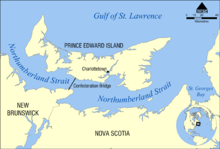Northumberland Strait
This article needs additional citations for verification. (February 2013) |
46°05′N 63°35′W / 46.083°N 63.583°W

The Northumberland Strait (French: détroit de Northumberland) is a
Boundaries
The western boundary of the strait is delineated by a line running between

Hydrography
The Northumberland Strait varies in depth between 17 and 65 metres, with the deepest waters at either end. The tidal patterns are complex; the eastern end has the usual two tides per day, with a tidal range of 1.2 to 1.8 metres, while the western end effectively has only one tide per day.[1][2]
The strait's shallow depths lend to warm water temperatures in summer months, with some areas reaching 25°C, or 77°F. Consequently, the strait is reportedly home to the warmest ocean water temperatures in Canada, and some of the warmest ocean water temperatures on the Atlantic coast north of Virginia.
There are many sandy beaches along both the northern and southern coasts of the strait. These beaches, found in New Brunswick, Prince Edward Island, and Nova Scotia, are very popular with tourists.
During the winter months between December and April, sea ice covers the entire strait and Gulf of St. Lawrence.
Geomorphology
While the western shores of
Settlements
Major communities on the strait include the cities of
Transportation

Shipping
The Northumberland Strait is a minor shipping route, with ports such as Pugwash shipping salt, Summerside, Charlottetown, Georgetown and Souris shipping agricultural products and receiving petroleum and aggregate, and Pictou shipping forestry products and general cargo. Shipping has declined in recent decades with the decline of rail service to ports and the increased capacity of highways to larger ports outside the Gulf of St. Lawrence, which freezes in the winter.
Cruise ships regularly visit Charlottetown during summer and fall, and since 2012 a few smaller cruise ships have been visiting Pictou, NS.[3]
Confederation Bridge
The narrowest part of the strait, the 13-kilometre (7–nautical mile) wide
Ferries
The strait hosts three seasonal ferry services:
- Northumberland Ferries Limited operates a passenger/vehicle service between Caribou, Nova Scotia and Wood Islands, Prince Edward Island.
- A passenger-only ferry service operates from Pictou Island.
- Cap-aux-Meules, Quebec.
All three ferry services are located in the eastern end of the strait and operate during the ice-free months from May - December.
There was a year-round ferry service that operated in the central/western part of the strait across
Undersea cables
- Electrical
- Telecommunications
Swim crossings
Swim-related details about crossings, tides, currents, marine life, and navigation can be found at OpenWaterPedia's Northumberland Strait page.
There have been several documented unassisted swim crossings of the strait, although there is no official body to verify these claims. All documented single and double crossings except one have been at the western end of the strait across the Abegweit Passage.
The first documented single crossing of
There have been two documented single-day double crossings of Abegweit Passage (approximately 27 kilometres (15 nmi)) with assistance to date:
The first and to date only, documented single crossing with assistance across the eastern end of the strait (approximately 24.5 kilometres (13.2 nmi) was made by Jill Leon of
Cultural significance
The strait is famous in
References
- ^ "Ice Climatology and Environmental Conditions". Fisheries and Oceans Canada. Retrieved 18 January 2016.
- ^ "Richibucto Cape Tidal Predictions". Fisheries and Oceans Canada. Retrieved 18 January 2016.
- ^ "County will see two cruise ship visits this fall". The Pictou Advocate. March 25, 2014. Retrieved 6 January 2016.[permanent dead link]
- ^ "P.E.I.'s underwater electric cable project officially plugged in - New underwater cables supply about 75% of the Island's electricity". CBC News. Aug 29, 2017. Retrieved 1 August 2020.
- ^ "PEI Sports Hall of Fame inductee Evelyn (Henry) Brown". Retrieved 2016-01-07.
- ^ "The Canadian Press: Halifax woman completes two-way swim of Northumberland Strait". Archived from the original on 2007-10-30. Retrieved 2008-08-13.
- ^ "The Charlottetown Guardian: She's Doing It for Everyone But Herself". Archived from the original on 2012-06-04. Retrieved 2008-08-13.
- ^ "Swimmer makes long swim to P.E.I. from Nova Scotia". Retrieved 2016-01-07.
- ^ "UPDATED: PEI swimmer takes on Northumberland Strait". Retrieved 2016-01-07.
External links
- Natural History of Nova Scotia - Northumberland Strait (Nova Scotia Museum)
- DFO Gulf Region Working Group on the Northumberland Strait Archived 2006-12-08 at the Wayback Machine
- CBC.CA 2007-02-21 "Northumberland Strait ecosystem in trouble"
- Northumberland Strait Ecosystem Overview and Assessment Report
